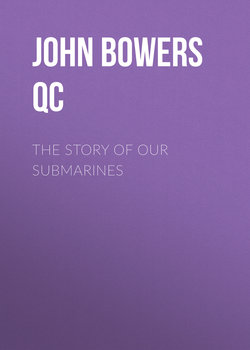Читать книгу The Story of Our Submarines - John Bowers QC - Страница 5
II
I
ОглавлениеBefore speaking of anti-submarine work, a very short description of the German submarine and its variations in type is advisable.
A U-boat is not unlike our ordinary patrol-type submarine. She varies in size and capabilities, but is generally a 16-knot (surface speed) boat, with two guns – a 4·1-inch and a 22-pdr., two bow and two stern torpedo-tubes, and about 800 tons surface displacement.
A U-B boat is a small patrol boat of about 500 tons surface displacement; one 4·1-inch or 22-pdr. gun, one stern and four bow torpedo-tubes, 13 knots surface speed. There is also a "Flanders," type U-B class, of 250 tons and 8½ knots speed. The latter class worked from Ostend and Zeebrugge.
A U-C boat is about 400 tons; one 22-pdr. gun, 12 knots speed, one stern and two bow torpedo-tubes. The Flanders type U-C's are of 180 tons and 7½ knots speed. All U-C's are primarily fitted for mine-laying.
The U cruisers are from 2000 to 3000 tons displacement, carry two 5·9-inch guns, have a speed of 16 knots, and in some cases are fitted as mine-layers in addition to their torpedo equipment.
The number of slight divergencies from the main types is considerable. Boats were built in standardised groups, and, during the second half of the war, in great quantities. On November 11th, 1918, the position was, roughly, as follows: 200 submarines in German hands, commissioned or completing – 135 (roughly) on the building slips. About 200 had been destroyed up to that date.
In 1918 the average number of German submarines at sea – in the Adriatic, Irish Sea, Channel, and North Sea – was (in the spring) 20, in October, 24. The number available for service – excluding Mediterranean boats, school boats, and boats out of date – was about 72; so that, roughly, one-third were kept at sea, and the remainder resting or repairing.
The medium-size German submarines are quite good-looking boats, but the German mind showed itself clearly in the U cruisers. It has been an axiom at sea since the days of the Vikings, that a thing that looks ugly isn't good seamanship. British submarines are better stream-lined than German boats, and have generally a more "varminty" and clean-run look. The sight of a U cruiser in dry dock recalls to one's mind a pair of pictures once published in 'La Vie Parisienne' – a Paris weekly which has done as much to win the war as any other periodical. The first picture showed a "seventy-five" gun, and standing beside it a girl built on clearly thoroughbred lines, balancing a cartridge on her hand. The second was of a squat 11-inch howitzer, accompanied by 'La Vie's' interpretation of a homely German Frau clutching the great shell to her portly figure. The two pictures illustrate rather well the ideas of our own K-boat designers as compared with the mental state of the authors of the German submarine cruisers.
